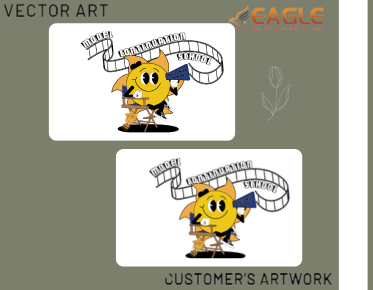Crafting Your Screen for Screen Printing: A Guide
Building your own screen for screen printing can be a rewarding endeavor, offering both creative freedom and cost savings. With a bit of patience and precision, you can craft a screen tailored to your specific needs, enhancing your screen printing experience. Let’s explore the process of creating your screen, from gathering materials to perfecting your prints. For the top-notch online vector conversion, don't hesitate to get in touch with us.
Why Build Your Screen?
The Benefits of DIY Screen Printing
Creating your screen offers numerous advantages. It allows for complete customization, enabling you to build a screen that fits your exact specifications and printing needs. The DIY approach also fosters a deeper understanding of the screen printing process, empowering you to troubleshoot and innovate. Additionally, it can be significantly more cost-effective than purchasing pre-made screens, making it an appealing option for hobbyists and small-scale printers.
Cost-Effective Solutions for Home Printers
DIY screen printing is a budget-friendly alternative to buying commercial screens. By sourcing materials locally and repurposing items you may already have, you can save money while achieving professional results. Building your screen also gives you the flexibility to experiment with different sizes and mesh types, allowing for a broader range of printing possibilities without breaking the bank.
Materials You’ll Need to Build Your Screen
Essential Tools and Supplies for Screen Building
To build your own screen, you’ll need a few essential tools and supplies. These include a frame (wood or aluminum), mesh fabric, a staple gun or adhesive, a squeegee, and tools for cutting and measuring. Additionally, you’ll need an emulsion and a light source for exposing your screen. Having these materials on hand ensures a smooth and efficient screen-building process.
Choosing the Right Mesh Count for Your Project
Mesh count is the number of threads per inch in the screen mesh. Higher mesh counts (e.g., 230 or above) are ideal for fine details and intricate designs, while lower counts (e.g., 110 or below) are better for bold, graphic prints. Selecting the right mesh count depends on the type of design you’re printing and the level of detail required.
Selecting the Perfect Frame Material: Wood vs. Aluminum
Frames can be made from wood or aluminum, each with its own set of advantages. Wooden frames are often more affordable and easier to build, but they can warp over time. Aluminum frames, on the other hand, are more durable and resistant to warping, providing a more stable base for the mesh. Your decision will be based on your budget and long-term requirements.
Step-by-Step Guide to Building Your Screen
Preparing Your Workspace: Setting Up for Success
Start by setting up a clean, well-lit workspace. Ensure that you have ample room to cut, measure, and assemble your screen. Gather all your tools and materials before you begin to streamline the process and avoid interruptions.
Measuring and Cutting the Frame: Precision is Key
Measure and cut your frame pieces to the desired size, ensuring that all corners are square and edges are smooth. Accurate measurements are crucial for assembling a frame that fits your mesh snugly and provides a stable base for printing.
Stretching the Mesh: How to Achieve a Taut Surface
Stretch the mesh over the frame, ensuring it’s taut and evenly aligned. Use a staple gun or adhesive to secure the mesh, pulling it tightly to avoid wrinkles or sagging. A well-stretched mesh is essential for achieving sharp, clean prints.
Securing the Mesh: Techniques for a Durable Screen
Once the mesh is stretched, secure it firmly to the frame using staples or adhesive. Ensure that all edges are tightly fastened to prevent the mesh from shifting or loosening during use. A durable screen will provide consistent results and stand up to repeated use.
Applying the Screen Mesh to the Frame
How to Align and Attach the Mesh Properly
Align the mesh carefully with the frame, ensuring that it is centered and straight. Attach the mesh starting from the center and working outward to ensure an even tension. Proper alignment prevents distortion in the print and ensures that your designs come out as intended.
Tips for Avoiding Common Mesh Stretching Mistakes
Avoid overstretching the mesh, as this can lead to warping and distortions in your prints. Ensure even tension across the entire screen and check for any wrinkles or uneven areas before securing the mesh completely. Proper stretching techniques will result in a smoother, more consistent print.
Ensuring a Smooth and Even Mesh Surface
Check the mesh surface for smoothness and evenness after securing it. Any bumps or uneven areas can affect print quality, so make any necessary adjustments to achieve a flawless surface. A well-prepared mesh ensures that your prints are clean and detailed.
Preparing Your Screen for Printing
Coating the Screen with Emulsion: What You Need to Know
Coat the screen with emulsion to create a light-sensitive layer that will hold your design. Apply an even, thin layer of emulsion to both sides of the screen, using a scoop coater or similar tool. Ensure that the emulsion is evenly spread and covers the entire mesh.
Drying and Curing the Emulsion: Best Practices
Allow the emulsion to dry in a dark, dust-free environment to prevent exposure to light. Once dry, cure the emulsion according to the manufacturer’s instructions to ensure it’s fully hardened. Proper drying and curing are essential for creating a durable stencil.
How to Expose Your Screen: DIY Exposure Units vs. Professional Equipment
Exposure can be done using a DIY exposure unit or professional equipment. DIY units may involve using a regular light bulb or sunlight, while professional equipment provides precise control over exposure times and light intensity. Select the method that best fits your setup and budget.
Creating and Applying Your Design
Transferring Your Design onto the Screen
Create a transparent film of your design and place it on the screen after exposure. The emulsion will harden where the light was blocked by your design, creating a stencil. Ensure that your design is properly aligned and securely positioned.
Techniques for Properly Applying the Design to Your Screen
Apply the design carefully to avoid misalignment or air bubbles. Use a squeegee to apply even pressure, ensuring that the design transfers clearly onto the emulsion. Proper application techniques will result in a crisp, accurate stencil.
Tips for Achieving Crisp and Clean Prints
Use high-quality inks and ensure that the screen is properly aligned with the substrate. Apply even pressure with the squeegee and avoid overloading it with ink. Proper technique and attention to detail will help achieve clean, sharp prints.
Testing Your Screen and Adjustments
How to Conduct a Test Print: What to Look For
Perform a test print to check the quality and accuracy of your screen. Examine the print for any inconsistencies, such as smudges or uneven areas. A test print helps identify any issues and allows for adjustments before beginning your final prints.
Troubleshooting Common Screen Printing Issues
Common issues include uneven ink distribution, misalignment, and screen clogging. Address these problems by adjusting your printing technique, cleaning the screen thoroughly, and ensuring proper alignment. Troubleshooting helps improve the quality of your prints and extends the life of your screen.
Making Adjustments to Improve Print Quality
If your test prints reveal problems, make necessary adjustments to the screen, ink, or printing technique. Re-check alignment, mesh tension, and ink consistency. Fine-tuning these elements will enhance print quality and achieve the desired results.
Cleaning and Maintaining Your DIY Screen
How to Clean Your Screen After Each Use
Clean your screen thoroughly after each use to remove ink and prevent buildup. Use appropriate cleaning solutions and tools to gently scrub the mesh without damaging it. Proper cleaning extends the life of your screen and ensures consistent print quality.
Storing Your Screen for Longevity
Store your screen in a clean, dry place to prevent damage and contamination. Do not expose it to harsh heat or intense sunshine. Proper storage helps maintain the screen’s integrity and performance.
Repairing Damaged Screens: Quick Fixes and Tips
If your screen becomes damaged, such as with tears or loose mesh, make quick repairs using appropriate materials. For minor issues, you can patch or re-stretch the mesh. Regular maintenance and prompt repairs keep your screen in optimal condition.
Advanced Tips for Customizing Your Screen
Adding a Hinged Frame for Easier Use
Incorporate a hinged frame to make handling and positioning your screen easier. Hinged frames allow for quick adjustments and simplify the printing process, especially for larger screens or multiple prints.
Creating Custom Frame Sizes for Specific Projects
Customize the size of your frame to fit specific projects or substrates. Building a frame to match the dimensions of your project ensures a perfect fit and improves the accuracy of your prints.
Enhancing Durability with Reinforced Edges
Reinforce the edges of your frame to increase its durability and resistance to wear. Adding metal corner brackets or additional layers of material helps maintain the frame’s shape and stability over time.
Cost and Budgeting for DIY Screen Printing Projects
How to Budget for Your DIY Screen Printing Setup
Plan your budget by estimating the costs of materials, tools, and any additional equipment needed. Consider purchasing supplies in bulk or from affordable sources to reduce expenses. Budgeting helps manage costs and ensures that you stay within your financial limits.
Cost Comparisons: DIY vs. Pre-Made Screens
Compare the costs of DIY screens with pre-made options to determine the best value. While DIY screens can be more cost-effective, pre-made screens offer convenience and consistent quality. Weigh the benefits of each option based on your needs and budget.
Maximizing Your Investment in Screen Printing Equipment
Invest in high-quality materials and tools to ensure the longevity and effectiveness of your DIY screen. Proper maintenance and care will help maximize your investment and enhance your screen printing experience. If this post spurred your interest and you want to find out more about vector conversion in USA, please feel free to contact us.
Building your screen for screen printing is a fulfilling and practical project. By understanding the materials, techniques, and processes involved, you can create a screen that meets your specific needs and enhances your printing capabilities. Embrace the DIY spirit, experiment with different approaches, and enjoy the creative satisfaction of crafting your screen.



